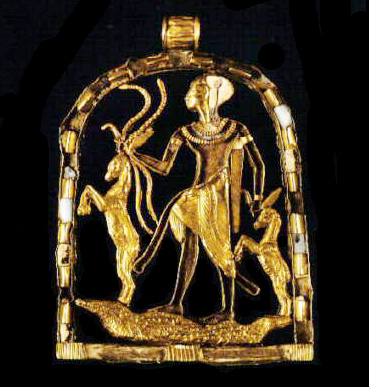January 3, 1999
Our week of waiting over, the 'gang of five' went to the "Splendors of Ancient Egypt" exhibit in Phoenix today. This is a touring show from the Roemer and Pelizaeus Museum in Hildesheim, Germany. It's been already to St. Petersburg in Florida, Houston, Detroit, Portland, and now we here in the southwest have our turn.
It was definitely worth the wait. Because of the Egyptian concern with death and the afterlife, much of their art has been preserved in their tombs. Stunning mummy portraits, and statues, big and small, of both the mighty and ordinary servants illustrate what their lives were like. Their passion for personal adornment was not limited merely to jewelry of gold and semi-precious stones and shells, but also facial cosmetics and wigs.
"The god Shed, "he who rescues," was an important force for personal protection against dangers of all kinds, including magic and illness. Shed is usually depicted as a young prince, wearing the side-lock hairstyle associated with children, a beaded collar, kilt, and an arrow quiver slung over his shoulder. He stands on two crocodiles and holds wild animals and serpents in his hands. Most of the colorful inlay has been lost on this piece, but the god's figure would have been finished with red carnelian."
This pendant from 1300 BC would seem to the uneducated eye to be merely for purposes of ornamentation. Yet there is a deeper meaning to some of their jewelry. There were at least twenty gods and goddesses who the Egyptians petitioned for various needs of their lives. But their interests were not only in matters of the supernatural, for they also had a great deal of knowledge of engineering, mathmatics and astronomy. They were the first to divide the day and night into twenty four hours and to use clocks. We also owe our calendar of 365 days to the Egyptians.
I will treasure today's memories always. Laura and Julia also have in their memory files, the Treasures of King Tut exhibit, for they saw it when it toured here in the states back in the early 'eighties. Julia was able to identify the brass throne Laura encouraged me to buy as a memento. It's a small replica of King Tut's throne, which appeared to be solid gold. Actually, the small book of Egyptian art we have describes it as carved wood, covered with a sheet of gold. Still it was quite awesome at that, with many-colored inlays in glass, majolica, silver and hard stone. (I have a photo from 2013 which shows that throne.)
Go to Travel Archives...
|
